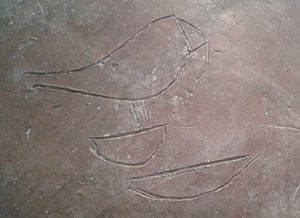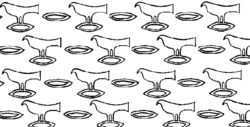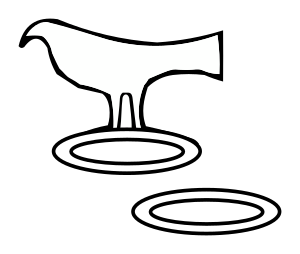Iry-Hor facts for kids
Quick facts for kids Iry-Hor |
|
|---|---|
| Ro, Irj-Hor, Iri(-Hor) | |

Signs r-Ḥr inscribed on a large vessel from the tomb of Iry-Hor, Ashmolean Museum.
|
|
| Pharaoh | |
| Reign | Early to Late 32nd century BC (Dynasty 0) |
| Predecessor | Scorpion I? Double Falcon? |
| Successor | Uncertain, possibly Ka |
| Burial | Chambers B1, B2, Umm el-Qa'ab |
Iry-Hor (or Ro) was a predynastic pharaoh of Upper Egypt during the 32nd century BC. Excavations at Abydos in the 1980s and 1990s and the discovery in 2012 of an inscription of Iry-Hor in the Sinai confirmed his existence. Iry-Hor is the earliest ruler of Egypt known by name and is sometimes cited as the earliest-living historical person known by name.
Contents
Name
Iry-Hor's name is written with the Horus falcon hieroglyph (Gardiner sign G5) above a mouth hieroglyph (Gardiner D21). While the modern reading of the name is "Iry-Hor", Flinders Petrie, who discovered and excavated Iry-Hor's tomb at the end of the 19th century, read it "Ro", which was the usual reading of the mouth hieroglyph at the time.
Given the archaic nature of the name, the translation proved difficult and, in the absence of a better alternative, Ludwig D. Morenz proposed that the literal translation be retained, giving "Horus mouth".
In the 1990s, Werner Kaiser and Günter Dreyer translated Iry-Hor's name as "Companion of Horus".
Toby Wilkinson translated the signs as "Property of the king".
The Egyptologists Jürgen von Beckerath and Peter Kaplony proposed that the known inscriptions referred to a private person whose name is to be read Wer-Ra, wr-rꜣ (lit. "great mouth"), i.e. reading the bird above the mouth-sign as the swallow hieroglyph G36 rather than the Horus falcon. They translated the name as "Spokesman" or "Chief".
Identity
Resolution
Dreyer's excavations of the necropolis of Abydos revealed that Iry-Hor was in fact well attested there with over 27 objects bearing his name and that his tomb was of royal proportions. Furthermore, in 2012 an inscription mentioning Iry-Hor was discovered in the Sinai, the inscription comprising furthermore an archaic empty serekh on the right of Iry-Hor's name. The inscription mentions the city of Memphis, pushing back its foundation to before Narmer and establishing that Iry-Hor was already reigning over it. Following this discovery, most Egyptologists, including G. Dreyer and the discoverers of the inscription, Pierre Tallet and Damien Laisney, now believe that Iry-Hor was indeed a king. Continuing excavations of Iry-Hor's tomb at Abydos by Dreyer established that the tomb was of similar dimensions and layout as those of Ka and Narmer and must, therefore, have belonged to a king. This was consequently accepted by von Beckerath and Iry-Hor is now the first entry in the latest edition of von Beckerath's Handbook of Egyptian Pharaohs.
Reign and attestations
Iry-Hor was most likely Ka's immediate predecessor and thus would have reigned during the early 32nd century BC. He probably ruled from Hierakonpolis over Abydos and the wider Thinite region and controlled Egypt at least as far north as Memphis, since the Sinai rock inscription relates a visit of Iry-Hor to this city. The Egyptologists Tallet and Damien Laisney further propose that Iry-Hor also controlled parts of the Nile Delta.
He was buried in the royal cemetery of Umm el-Qa'ab near Ka, Narmer and the First Dynasty kings. Iry-Hor's name appears on clay vessels from his tomb in Abydos and a clay seal with the hieroglyphs for r-Ḥr was found in Narmer's tomb and may refer to Iry-Hor. In total, no less than 22 pottery jars incised with Iry-Hor's name have been in Abydos as well as at least 5 ink-inscribed fragments and a cylinder seal. A similar seal was also found far to the north in the tomb Z 401 of Zawyet el'Aryan in Lower Egypt. An incision on a spindle whorl found in Hierakonpolis during James E. Quibell and Petrie excavations there in 1900 may refer to him. Finally, the discovery of a rock inscription of Iry-Hor in the Sinai constitutes his northernmost attestation. The inscription shows the name of Iry-Hor on a boat, next to the word Inebu-hedj meaning "white walls", the ancient name of Memphis.
Tomb
Iry-Hor's tomb is the oldest tomb of the Abydos necropolis B in the Umm el-Qa'ab. It comprises two separate underground chambers B1 (6 m × 3.5 m) and B2 (4.3 m × 2.45 m) excavated by Petrie in 1899 and later by Werner Kaiser. A further chamber, now known as "B0", was uncovered during re-excavations of Iry-Hor's tomb in the 1990s. These chambers have a size similar to those found in the tombs of Ka and Narmer. No superstructure, if there ever was one, survives to this day. Chamber B1 yielded jar fragments incised with his name. Chamber B2 produced another incised jar fragment, a seal impression, several ink inscriptions and vessel fragments bearing the names of Ka and Narmer. Parts of a bed were also found onsite.
See also
 In Spanish: Horus Iry para niños
In Spanish: Horus Iry para niños
- Naqada III, also called Dynasty 0
- Kushim





